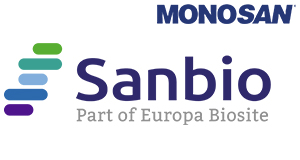Mouse anti-Rat SR-BI, clone 3D12 (Monoclonal)
Mouse anti-Rat SR-BI, clone 3D12 (Monoclonal)
SKU
SANMON7078
Packaging Unit
1 ml
Manufacturer
Sanbio / Monosan
Availability:
loading...
Price is loading...
Clone Number: 3D12
Immunogen: Unknown or proprietery to MONOSAN and/or its suppliers
Concentration: 100 ug/ ml
Storage buffer: PBS with 0.1% BSA and 0.02% sodium azide
Additional info: Monoclonal antibody 3D12 reacts with rat class B scavenger receptor type I (SR-BI). Scavenger receptors have been studied primarily for their ability to bind and internalize modified lipoproteins. They have been found in the development of atherosclerosis and other macrophage-associated functions. Scavenger receptors also function as pattern recognition receptors for a wide variety of pathogens. This finding indicates a potential role in host defense. SR-BI belongs together with CD36 to the class B scavenger receptor family. SR-BI is a multiligand membrane protein existing in various organs such as the liver and various cell types such as endothelial cells, macrophages, brain cells, Leydig cells and Sertoli cells. SR-BI has been found as a receptor for phospholipids, free and (lipo)protein-bound ApoE, lipid-bound ApoA-I, HDL, hypochlorite-modified LDL and more. In liver, the PDZK-1 (and possible other PDZ domains) of SR-BI has been found to be essential for cell surface expression and, hence, reverse cholesterol transport. In the brain, the presence of SR-BI seems to be involved in the uptake of oxidatively modified lipoproteins and beta-amyloid protein complexed with ApoE, suggesting SR-BI to be an important tool for studies on neurodegenerative disorders. In the testis, SR-BI is expressed in two somatic cell types: Leydig cells and Sertoli cells. SR-BI functions at least partly as a phosphatidyl serine receptor (PSR), enabling Sertoli cells to recognize and phagocytose apoptotic spermatogenic cells at all stages of differentiation. Monoclonal antibody 3D12 blocks the biological activity of rat SR-BI. For example, it inhibits the ability of SR-BI to mediate the corporation of lipids of HDL by SR-BI expressing cells.
References: Nakagawa; A et al. Develop Growth Differ 2004; 46: 283
Immunogen: Unknown or proprietery to MONOSAN and/or its suppliers
Concentration: 100 ug/ ml
Storage buffer: PBS with 0.1% BSA and 0.02% sodium azide
Additional info: Monoclonal antibody 3D12 reacts with rat class B scavenger receptor type I (SR-BI). Scavenger receptors have been studied primarily for their ability to bind and internalize modified lipoproteins. They have been found in the development of atherosclerosis and other macrophage-associated functions. Scavenger receptors also function as pattern recognition receptors for a wide variety of pathogens. This finding indicates a potential role in host defense. SR-BI belongs together with CD36 to the class B scavenger receptor family. SR-BI is a multiligand membrane protein existing in various organs such as the liver and various cell types such as endothelial cells, macrophages, brain cells, Leydig cells and Sertoli cells. SR-BI has been found as a receptor for phospholipids, free and (lipo)protein-bound ApoE, lipid-bound ApoA-I, HDL, hypochlorite-modified LDL and more. In liver, the PDZK-1 (and possible other PDZ domains) of SR-BI has been found to be essential for cell surface expression and, hence, reverse cholesterol transport. In the brain, the presence of SR-BI seems to be involved in the uptake of oxidatively modified lipoproteins and beta-amyloid protein complexed with ApoE, suggesting SR-BI to be an important tool for studies on neurodegenerative disorders. In the testis, SR-BI is expressed in two somatic cell types: Leydig cells and Sertoli cells. SR-BI functions at least partly as a phosphatidyl serine receptor (PSR), enabling Sertoli cells to recognize and phagocytose apoptotic spermatogenic cells at all stages of differentiation. Monoclonal antibody 3D12 blocks the biological activity of rat SR-BI. For example, it inhibits the ability of SR-BI to mediate the corporation of lipids of HDL by SR-BI expressing cells.
References: Nakagawa; A et al. Develop Growth Differ 2004; 46: 283
| SKU | SANMON7078 |
|---|---|
| Manufacturer | Sanbio / Monosan |
| Manufacturer SKU | MON7078 |
| Package Unit | 1 ml |
| Quantity Unit | STK |
| Reactivity | Rat (Rattus) |
| Clonality | Monoclonal |
| Application | Immunohistochemistry (frozen), Flow Cytometry, Functional Assay |
| Isotype | IgG1 |
| Host | Mouse |
| Conjugate | Unconjugated |
| Product information (PDF) | Download |
| MSDS (PDF) |
|

 Deutsch
Deutsch







